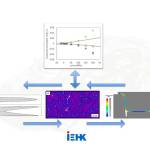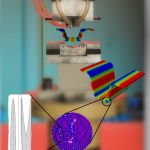M4 PressBain
| Dr.-Ing. Martin Hunkel | Dr.-Ing. Ulrich Prahl |
 |
 |
| hunkel@iwt-bremen.de | ulrich.prahl@iehk.rwth-aachen.de |
| Prof. Dr. Robert Spatschek | M. Sc. Marc Weikamp |
 |
 |
| r.spatschek@fz-juelich.de | m.weikamp@fz-juelich.de |
| M. Sc. Diego Schicchi | M. Sc. Mingxuan Lin |
 |
 |
| schicchi@iwt-bremen.de | mingxuan.lin@iehk.rwth-aachen.de |
Press hardening is an important processing technology for the production of safety relevant components for automotive applications. The parts are hot formed in the austenitic state in a tool with defined tool temperature below 550 °C and afterwards quenched under load inside this tool. This technology allows forming of complex shaped parts made of ultrahigh strength steels. Depending on quenching conditions martensitic or bainitic microstructures form, with a strong coupling between mechanical load, internal stresses, chemical composition and phase transformation kinetics.
In this project we will focus on the austenite-to-bainite transformation during a partial or bainitic press hardening process, using tools of about 400 – 500 °C. Due to processing conditions, the bainite forms from a pre-strained austenite under high stresses. In this scale-bridging project we aim for a fundamental understanding of the underlying bainitic transformations in a bottom-up approach. We start from the theoretical description of bainitic platelets and sheaves on the smallest scales using phase field methods. The outcome from these phase front growth predictions will be connected to an intermediate modeling step on the mesoscale level, which pursues the prediction of transformation kinetics and material properties in representative volume elements, involving plastic deformations. Phase fractions will be predicted using coarser grained phase field models combined with a crystal plasticity finite element approach. Handshaking with macroscopic descriptions based on a mean field concept combined with kinetic models will allow for a theory-guided prediction of transformation kinetics and the mechanical behavior under the influence of mechanical load. Here, finite element based models allow to predict the mechanical behavior of entire work pieces during processing.
The trilogy of modeling levels will be compared to experimental investigations of bainite formation during press hardening. Advanced electron microscopy using EBSD+EDX, HR-EPMA and TEM will be applied within this project for quantitative microstructure kinetics evaluation. This allows to directly validate the simulation predictions on different scales and allows for improvements of the theoretical descriptions, as well as to link experimental setups and conditions to the multi-scale modeling approach.
The main goal of the project is to develop a bottom-up understanding of bainitic transformations in particular under the influence of applied stresses, and to set the path for a theory-guided improvement of processing steps during advanced press hardening of high strength steel sheet components for safety applications.


